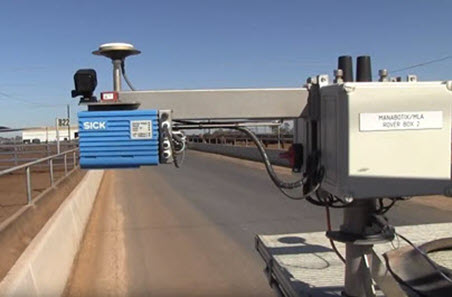Bunk scanner proves its accuracy

Extensive in-feedlot testing of a prototype bunk scanner has demonstrated that it’s more accurate in predicting feed remaining in bunks than human callers, offering potential productivity and profitability benefits to the feedlot industry.
After successful development of the vehicle-mounted prototype bunk scanner by Australian automation and robotics solutions company, Manabotix, earlier this year, MLA in consultation with the Australian Lot Feeders’ Association (ALFA) funded a series of observation trials.
Manabotix tested the prototype at three feedlots including Mort & Co Grassdale, Mort & Co Pinegrove and Teys Condamine feedlot.
Manabotix Managing Director, Dr Stuart McCarthy, said 100 observations were taken at each feedlot, with feed quantities in bunks representing the full spectrum.
“Success of correctly applying bunk scores was higher across all three sites, with very high resolution at both high and low quantities in the bunk,” Dr McCarthy said.
“At all three sites, the bunk scanner was more precise and accurate than human bunk callers.”
Teys Condamine Feedlot General Manager, Phil Lambert, said the bunk scanner offered a range of potential benefits to the industry.
“With current ration prices as high as they are, we need full utilisation of all feed in the bunk to ensure allocation is as accurate as possible, not only for cattle performance but to prevent wastage,” Phil said.
“We’ve got an experienced group of feed callers, however, once there was over 100kg of feed remaining in bunks in each pen, the difference in accuracy between the bunk scanner and the callers became evident. Inaccuracies in the estimations of human callers was particularly noticeable over the 300kg mark.
“With margins being so tight, we need to make sure every mouthful counts. So many other variables in the feeding process have been addressed and removed, so if we can remove human error from another area, it would certainly be a benefit,” he said.
Teys Condamine has a range of different bunk shapes and sizes in the yard; however, the bunk scanner produced the same level of accuracy, regardless of the bunk.
Phil said that even if a feedlot didn’t use the bunk scanner full-time, it would be a great training tool for getting new feed callers started and calibrating and re-aligning their skills.
Mort & Co Pinegrove Feedlot Manager, Jeff Jurd, said the accuracy of the bunk scanner during testing at the feedlot demonstrated it would enable feedlots to make better decisions.
“Every day, the bunks get called at 6am and then again at 8.30am. The information collected in that timeframe about the amount of feed left in bunks is crucial to determining if we increase feed that day to each pen, or decrease it,” Jeff said.
“If we over-estimate, we might reduce the feed unnecessarily, so having greater accuracy is a huge benefit.
“Also, as a vehicle mounted unit, it would allow someone who isn’t trained in bunk calling to collect the data and then for someone else interpret it.
“Our site also has three different bunk designs, and the scanner was successfully tested across all of them,” he said.
The vehicle-mounted prototype’s primary sensing element is based on light detection and ranging (LIDAR) technology.
“We have onboard positioning solutions so we know very accurately where the vehicle is in a world coordinate system, and we also have an onboard attitude solution so we can account for any vehicle roll and rock and any other dynamic events to improve the quality of the signal,” Dr McCarthy said.
“The scanner has an onboard computer which takes in all of that information. It predicts how much feed is remaining and then it publishes the result at the end of measuring each bunk. It can work in day and night conditions.
“We believe the real value to be in how much more accurate the scanner is over humans. Humans at all sites tended to have what is known as ‘linear bias’. In simple terms, this means they increasingly mis-estimate the quantity of feed remaining in bunk as the actual quantity increases. The bunk scanner has no linear bias and performs with equal resolution at low and high quantities of feed remaining in the bunk.
“The commercial realities of this remain to be researched, but shows there is room for improvement in how we manage bunks in feedlots.”
MLA thanks Manabotix, Mort & Co, Teys Australia and ALFA for their innovative support in completing the bunk scanner trials successfully.
The bunk scanner will be commercially launched at BeefEx at Brisbane in October and is anticipated to be available to the industry later this year.
Contact:



